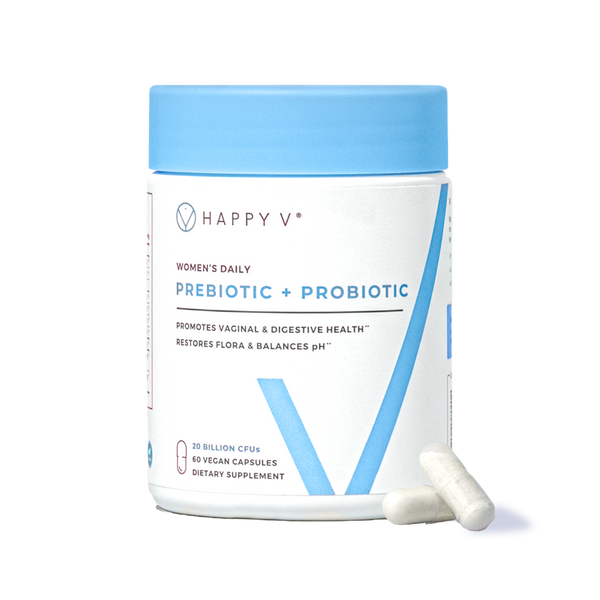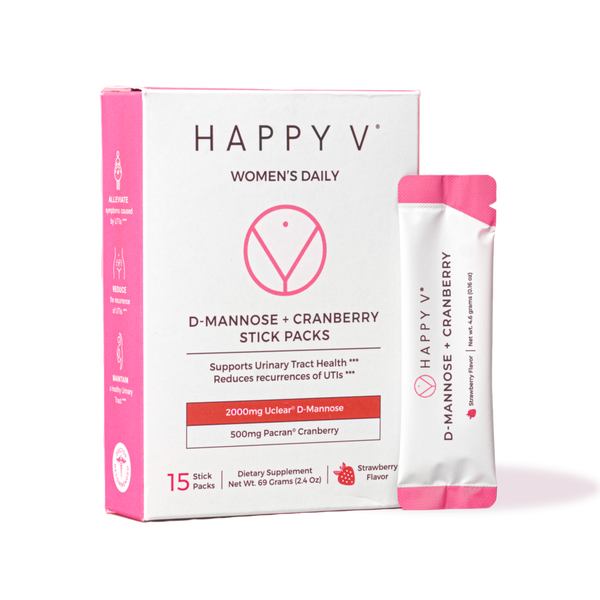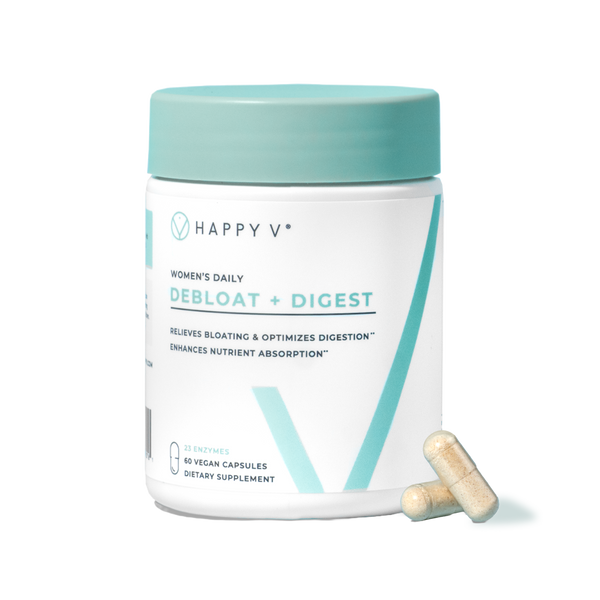- Fact Checked
- July 18, 2025
- 5 min read
Table of Contents
Table of Contents
Let’s set the scene: you’re dealing with a yeast infection. It’s annoying, uncomfortable, and definitely not part of your date night plan, and you can’t help but wonder… can you still have sex with a yeast infection?
If you're navigating vaginal yeast infections and feel unsure about what’s okay in the bedroom, you're not alone. At Happy V, we believe in clear, no-shame conversations about women’s health and sexual activity. Here’s what you need to know about intimacy and yeast infections—backed by facts, not fear.
This post is for informational purposes only and does not constitute medical advice. See full disclaimer below.
Should You Have Sex with a Yeast Infection?
Technically? You could.
Comfort-wise and health-wise? Probably best to wait.
Yeast infections, also called vaginal candidiasis or vulvovaginal candidiasis, are a type of fungal infection caused by an overgrowth of yeast, most commonly Candida albicans1. They’re super common and can happen to anyone with a vulva, especially when the immune system is stressed or your vaginal pH is disrupted.
Symptoms of a yeast infection often include:
- Vaginal itching or irritation2
- A thick, white vaginal discharge (think “cottage cheese” texture)3
- Redness or swelling around the vulva
- Burning during urination or intercourse4
When you add friction and body fluids to an already inflamed vaginal area, sex can not only be painful, but it can actually set you back in your recovery5.
Can You Pass a Yeast Infection to a Partner?
Yeast infections are not officially considered sexually transmitted infections (STIs) or sexually transmitted diseases (STDs)6, but they can still be passed between partners during sexual activity.
Candidiasis can affect both men and women, especially during unprotected genital contact or oral sex7. Sharing a sex toy without cleaning it properly may also spread yeast.
If you or your sexual partner has symptoms like itching or a rash in the genital area, they should reach out to a healthcare provider for support.
Risks of Having Sex During a Yeast Infection
Even if you're tempted, here’s why waiting might be the gentler choice:
1. It Might Worsen Your Symptoms
Sexual friction can increase itchiness, swelling, and general discomfort8.
2. It Could Interfere with Treatment
Many yeast infection treatments—like suppositories or antifungal medications—need time and space to do their job9. This means intercourse may reduce the effectiveness of Monistat or miconazole vaginal creams.
If you're taking an oral antifungal like fluconazole, your body still needs a few days post-dose to restore balance. Having sex too soon may prolong your healing.
3. You Could Pass It On
As we mentioned earlier, candida can spread through sexual contact, even if your partner isn’t showing symptoms10. Reinfection is real (and really frustrating).
Can You Use Condoms During Yeast Infection Treatment?
Using condoms can prevent the spread of yeast during a yeast infection11, but it won’t prevent symptom-prolonging irritation. There are other things you need to know when it comes to condom use during yeast infection treatment, especially if condoms are your primary form of birth control:
- Some over-the-counter (OTC) treatments may weaken latex condoms12.
- If you're using vaginal creams or antifungal suppositories, double-check the packaging or speak with a healthcare professional for guidance.
So… How Long Should You Wait?
Every body is different, but many healthcare providers recommend holding off on sexual activity until:
- You’ve completed your full course of antifungal treatment
- Your symptoms of a yeast infection are fully gone
- You feel physically comfortable again13
This may be a few days with an oral medication like fluconazole, or up to a week or more with OTC treatments like Monistat or miconazole creams. For lingering symptoms or recurrent infections, check in with your gynecologist or primary healthcare team.
Talking to Your Partner About It
A healthy sex life starts with honest conversations. If you're navigating vaginal infections, especially recurrent ones, let your partner know what's up. You’re not contagious in the STI sense, but you do deserve to prioritize comfort and healing.
If you’re like our founders, Daniella and Hans, you will find that these types of conversations will actually bring you closer.
How to Reduce Future Risk
Sometimes, yeast infections happen no matter what you do. It’s often part of being a proud vagina owner14. But if you are experiencing recurrent yeast infections, here are some smart steps to take to break the cycle:
- Wear cotton underwear and change out of swimsuits or sweaty clothes quickly15
- Avoid using a douche, scented wipes, or harsh cleansers around the vulva
- Explore probiotic support with your healthcare provider, especially a probiotic designed for vaginal health with clinically proven strains of Lactobacilli, like LA-14® and HN001™
- Use barrier protection during sex, especially right after treatment for a yeast infection
Bonus: Some find that skipping tampons during a yeast infection helps ease irritation, but everyone’s comfort level is different.
Final Thoughts: Your Body, Your Call
Whether you choose to wait or not, the bottom line is this: vaginal yeast infections are common, treatable, and not something to be ashamed of. At Happy V, we believe in supporting your vaginal health through honest education, microbiome-friendly products, and science-backed care.
If you’re unsure whether your symptoms are yeast-related—or if something feels off—consult a licensed healthcare provider. When it comes to your women’s health, you're your best advocate.
Keep the Conversation Going
- Visit our blog for more on BV treatment options and women’s health tips.
- Join our private Happy V Facebook group to hear from others who’ve been there.
- Explore supplements designed to support your vaginal health journey.
Disclaimer: This blog is for informational and educational purposes only and is not intended to diagnose, treat, cure, or prevent any disease. Statements about supplements have not been evaluated by the Food and Drug Administration. For more information about vaginal infections, visit the CDC or speak to a licensed healthcare provider.








